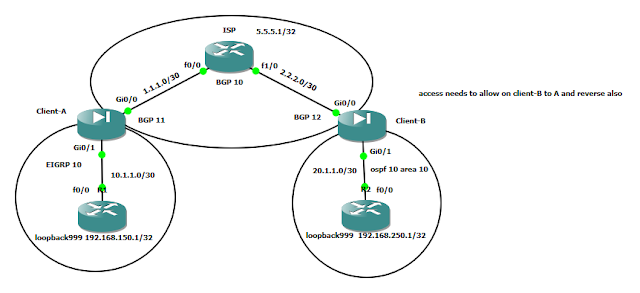BGP ATTRIBUTES
BGP Attributes Categories
A quick copy-and-paste summary on BGP attribute categorization.
WELL-KNOWN, MANDATORY
AS-path: A list of the Autonomous Systems (AS) numbers that a route passes through to reach the destination. As the update passes through an AS the AS number is inserted at the beginning of the list. The AS-path attribute has a reverse-order list of AS passed through to get to the destination.
Next-hop: The next-hop address that is used to reach the destination.
Origin: Indicates how BGP learned a particular route. There are three possible types -- IGP (route is internal to the AS), EGP (learned via EBGP), or Incomplete (origin unknown or learned in a different way).
WELL-KNOWN, DISCRETIONARY
Local Preference: Defines the preferred exit point from the local AS for a specific route.
Atomic Aggregate: Set if a router advertises an aggregate causes path attribute information to be lost.
OPTIONAL, TRANSITIVE
Aggregator: Specifies the router ID and AS of the router that originated an aggregate prefix. Used in conjunction with the atomic aggregate attribute.
Community: Used to group routes that share common properties so that policies can be applied at the group level.
OPTIONAL, NON-TRANSITIVE
Multi-exit-discriminator (MED): Indicates the preferred path into an AS to external neighbors when multiple paths exist.
A list of path attributes is contained in BGP update messages. The attribute is variable length and consists of three fields: Attribute type consisting of a 1-byte attribute flags field and a 1-byte attribute code field, Attribute length field that is 1 or 2 bytes, and a variable length attribute value field. The attribute type codes used by Cisco are: 1-origin, 2-AS-path, 3-Next-hop, 4-MED, 5-Local preference, 6-Atomic aggregate, 7-aggregator, 8-community, 9-originator-ID, and 10-cluster list.
WELL-KNOWN, MANDATORY
AS-path: A list of the Autonomous Systems (AS) numbers that a route passes through to reach the destination. As the update passes through an AS the AS number is inserted at the beginning of the list. The AS-path attribute has a reverse-order list of AS passed through to get to the destination.
Next-hop: The next-hop address that is used to reach the destination.
Origin: Indicates how BGP learned a particular route. There are three possible types -- IGP (route is internal to the AS), EGP (learned via EBGP), or Incomplete (origin unknown or learned in a different way).
WELL-KNOWN, DISCRETIONARY
Local Preference: Defines the preferred exit point from the local AS for a specific route.
Atomic Aggregate: Set if a router advertises an aggregate causes path attribute information to be lost.
OPTIONAL, TRANSITIVE
Aggregator: Specifies the router ID and AS of the router that originated an aggregate prefix. Used in conjunction with the atomic aggregate attribute.
Community: Used to group routes that share common properties so that policies can be applied at the group level.
OPTIONAL, NON-TRANSITIVE
Multi-exit-discriminator (MED): Indicates the preferred path into an AS to external neighbors when multiple paths exist.
A list of path attributes is contained in BGP update messages. The attribute is variable length and consists of three fields: Attribute type consisting of a 1-byte attribute flags field and a 1-byte attribute code field, Attribute length field that is 1 or 2 bytes, and a variable length attribute value field. The attribute type codes used by Cisco are: 1-origin, 2-AS-path, 3-Next-hop, 4-MED, 5-Local preference, 6-Atomic aggregate, 7-aggregator, 8-community, 9-originator-ID, and 10-cluster list.

Comments
Post a Comment